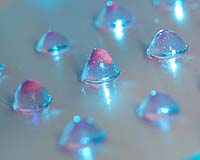 |
Evanston, IL (SPX) Feb 23, 2011 To build the next generation of sensors - with applications ranging from medical devices to robotics to new consumer goods - Chang Liu looks to biology. Liu, professor of mechanical engineering and electrical engineering and computer science at Northwestern University's McCormick School of Engineering and Applied Science, is using insights from nature as inspiration for both touch and flow sensors - areas that currently lack good sensors for recording and communicating the senses. Liu will discuss his research in a symposium at the annual meeting of the American Association for the Advancement of Science (AAAS) in Washington, D.C. For the past 10 years, Liu has led a research group that develops artificial hair cell sensors. Hair cells provide a variety of sensing abilities for different animals: they help humans hear, they help insects detect vibration, and they form the lateral line system that allows fish to sense the flow of water around them. "The hair cell is interesting because biology uses this same fundamental structure to serve a variety of purposes," Liu says. "This differs from how engineers typically design sensors, which are often used for a specific task." By creating artificial hair cells using micro- and nanofabrication technology, Liu's group is increasing sensor performance while deepening the understanding of how different creatures use these sensors. For example, every fish in the world uses hair cells in the lateral line as sensors, but so far no manmade vehicle does. If a submarine had sensors similar to that of a fish, it could record much more information on water movement. Liu's current focus is the medical application of these biologically inspired sensors. He hopes that artificial hair cells could be used to measure acoustics in an artificial cochlea or could be embedded as flow sensors in a wide variety of medical devices. Liu is also developing new touch sensors to improve minimally invasive surgery techniques. Currently many minimally invasive procedures are conducted through a catheter that is inserted into the body and controlled by a doctor on the outside. "During a heart treatment, the doctor controlling the catheter has no sense of touch and cannot tell if the catheter has touched the heart wall and successfully completed the therapeutic treatment," Liu explains. "We want to use microfabrication technology to put sensors on the end of the catheter to provide feedback." In order to achieve his goals, Liu has assembled a multidisciplinary team that includes biologists, engineers, materials scientists and physicians. A mix of fundamental and applied research is necessary to make biologically inspired sensors a reality, he says. "Using a bio-inspired approach is really important," Chang says. "Nature has a lot of wonderful examples that can challenge us. No matter how good some of our technology is, we still can't do some of the basic things that nature can. Nature holds the secret for the next technology breakthrough and disruptive innovation. We are on a mission to find it."
Share This Article With Planet Earth
Related Links Northwestern University Space Technology News - Applications and Research
 Hydrogels Used To Make Precise New Sensor
Hydrogels Used To Make Precise New SensorWest Lafayette IN (SPX) Feb 21, 2011 Researchers are developing a new type of biological and chemical sensor that has few moving parts, is low-cost and yet highly sensitive, sturdy and long-lasting. The "diffraction-based" sensors are made of thin stripes of a gelatinous material called a hydrogel, which expands and contracts depending on the acidity of its environment. Recent research findings have demonstrated that th ... read more |
|
| The content herein, unless otherwise known to be public domain, are Copyright 1995-2010 - SpaceDaily. AFP and UPI Wire Stories are copyright Agence France-Presse and United Press International. ESA Portal Reports are copyright European Space Agency. All NASA sourced material is public domain. Additional copyrights may apply in whole or part to other bona fide parties. Advertising does not imply endorsement,agreement or approval of any opinions, statements or information provided by SpaceDaily on any Web page published or hosted by SpaceDaily. Privacy Statement |